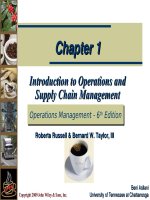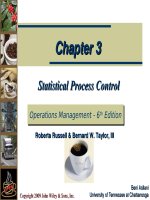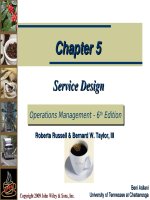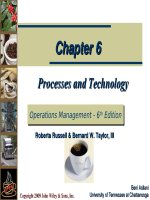Enterprise systems for management 2nd by motiwalla and thompson chapter 05
Bạn đang xem bản rút gọn của tài liệu. Xem và tải ngay bản đầy đủ của tài liệu tại đây (342.64 KB, 30 trang )
CHAPTER 5
IMPLEMENTATION
STRATEGIES
1
Copyright © 2012 Pearson Education, Inc. Publishing as Prentice Hall
Learning Objectives
• Acquire a greater knowledge base of ERP components
and how they work together to support business.
• Learn why third party products are needed to
operationally round out ERP system functionality and
the issues involved in using them.
• Appreciate the impact of an ERP implementation on
platform components such as data security, system
reliability, and sustainability.
• Understand implementation approaches, the
differences between vanilla and chocolate
implementations, and the short and long term impacts
on the system and company.
2
Copyright © 2012 Pearson Education, Inc. Publishing as Prentice Hall
Preview
• A start-up process involves assessing the business
environment, culture, and skills of the staff and
“readiness” of the company.
• Early in the project, open and honest assessments are
critical to project planning
• It is often said that the ERP software is the inexpensive
component of an implementation—other surrounding
systems components and resources cost more.
• With any ERP implementation strategy, all the
implementation components need to be identified and
planned.
3
Copyright © 2012 Pearson Education, Inc. Publishing as Prentice Hall
ERP Components
• Hardware
– An ERP system will require a powerful set of servers for
development, testing, and production environments.
• Key Resources
– Servers. High-end multiprocessor systems, several gigabytes
of main memory and several terabytes of secondary storage
– Clients. People accessing ERP systems (e.g., end-users, IT
support staff, and developers)
– Peripherals. Print servers, printers, back-up power supply
equipment, and networking hardware
4
Copyright © 2012 Pearson Education, Inc. Publishing as Prentice Hall
ERP Components (Cont’d)
• Software
– A set of operating instructions and logic called programs that
control and direct the computer hardware to perform its
functions.
• Key Components
– System Software. Operating system platform (e.g., Microsoft
Windows Server, Linux, and Sun Solaris)
– Database Management System (DBMS). (SAP/R3 works with
IBM-DB2, Oracle, Microsoft SQL)
– Application Software. Project management software,
development software, remote access software, and automated
software for monitoring system traffic, virus protection, etc.
5
Copyright © 2012 Pearson Education, Inc. Publishing as Prentice Hall
Figure 5-1 Typical ERP Architecture
6
Copyright © 2012 Pearson Education, Inc. Publishing as Prentice Hall
Table 5-1 Software Components with
Oracle/PeopleSoft ERP
7
Copyright © 2012 Pearson Education, Inc. Publishing as Prentice Hall
ERP Components (Cont’d)
• People Resources
– End-users. Employees, clients, vendors, and others who will
ultimately use the system
– IT specialists. Database administrators, IT operations support,
developers, change management, trainers, and others in IT
– The project manager. Puts together a harmonious team, works
with top management in getting support and resources for the
project, and champion the system and its benefits to the endusers
• ERP implementation team includes various sub-teams
from business or functional areas, change management,
development, data migration, and system support.
8
Copyright © 2012 Pearson Education, Inc. Publishing as Prentice Hall
ERP and Virtualization
• A virtual machine (VM) server technology can be
described as providing a “technique to run multiple and
isolated virtual servers on a single physical device, thus
optimizing hardware usage.”
• Each virtual server that is installed in the same physical
server operates under its own OS independently of the
other VMs present
• The two more common models used for mission critical
application are known as
– Hardware virtualization
– Paravirtualization
9
Copyright © 2012 Pearson Education, Inc. Publishing as Prentice Hall
ERP Vendors and Virtualization
• Microsoft: The two virtualization choices available are
Microsoft Virtual Server and Microsoft Virtual PC.
“Microsoft does not test or support its software running
together with non-Microsoft virtualization software”
• Oracle: Same as Microsoft. Oracle VM uses paravirtualization architecture based on the Xen open-source
technology that brings with it both Linux and Windows
support
• SAP: Strategy does not dictate what software customers
can use to virtualize applications. They provide customers
with tools, code tweaks, and support needed to make sure
their SAP virtualization projects go smoothly.
10
Copyright © 2012 Pearson Education, Inc. Publishing as Prentice Hall
Benefits of Virtualization
• Enhanced hardware utilization allowing an organization to
consolidate underutilized servers
• Makes provisioning and deploying more agile.
• Through consolidation, virtualization can lower total cost
of operations TCO at the data center by the following:
– Deferred purchase of new servers
– Smaller data center footprint
– Lower maintenance costs
– Lower power, ventilation, cooling, rack, and cabling requirements
– Lower disaster recovery costs
– Reduced server deployment costs
• Enhances business continuity and availability
11
Copyright © 2012 Pearson Education, Inc. Publishing as Prentice Hall
Drawbacks of Virtualization
• Tendency to try to squeeze more performance out of a
physical server by creating too many virtual machines
leading to significant concerns when the server is
operating at peak loads
• Security- If a hacker compromises the security of the
hypervisor, he or she might get access to all virtual
machines running on the host server
12
Copyright © 2012 Pearson Education, Inc. Publishing as Prentice Hall
Third Party Products
• Add-on software components either to make the system
operational or to add missing functionality.
• Integration with ERP
– Integration defined as the sharing of data and data elements
directly with the ERP system without data redundancy.
• Strategic Partners
– Assist in addressing integration and interface issues with third
party products
• Middleware
– Assists with the development of reporting databases that use
extract translate and load tools
• Support- Third party product support
13
Copyright © 2012 Pearson Education, Inc. Publishing as Prentice Hall
Database Requirements
• For an ERP system to perform up to expectations, the
update or transactional component and the reporting
component must respond in a timely fashion.
• Large ERP system implementations require a robust
relational database system (Oracle, DB2, Sybase,
Microsoft SQL).
• Selecting a relational database
– Availability of software applications
– Availability of skilled, trained technical staff
– Overall functionality of the database itself
• Staffing and database Administration
– Options include the use of full time staff and consultants.
14
Copyright © 2012 Pearson Education, Inc. Publishing as Prentice Hall
ERP Approaches
• Governance
– Governance should outline and define committees and
workgroups that are responsible for the different components of
the implementation, their interaction and decision making.
– Components
•
•
•
•
•
•
•
•
•
Technical development
Hardware and software installation
Functional components
Communications and reporting
Change management
Project management
Project owners and sponsors
Budget management
Issue escalation process
15
Copyright © 2012 Pearson Education, Inc. Publishing as Prentice Hall
Roles and Responsibilities
• Owners (Consisting of Senior Management)—
Determine overall policy, budget, and scope of the
project.
• Project Executive—Oversees project activities,
provides broad project oversight, resolves policy level
issues, and ensures that the project stays within scope.
• Steering Committee—Oversee the project’s efforts and
ensure appropriate leadership.
• Application Steward—Works with the other business
owners to develop an overall business direction of the
system, developing consensus, and resolving functional
issues raised to the steering committee.
16
Copyright © 2012 Pearson Education, Inc. Publishing as Prentice Hall
Roles and Responsibilities (Cont’d)
• Chairperson—Oversee the activities of the steering
committee, ensuring that the committee functions in
accordance with the overall project oversight. This
includes budget, resources, deliverables, risk, and
expectations management.
• Project Management Office—Consists of the project
executive, business and technical project manager(s),
and the implementation partner. Manage the day-to-day
aspects of the project.
17
Copyright © 2012 Pearson Education, Inc. Publishing as Prentice Hall
Roles and Responsibilities (Cont’d)
• Project Teams—Provide direction and ERP application
knowledge with respect to business process design,
configuration, conversion, testing, training, reporting,
and implementation. The following teams will exist:
–
–
–
–
–
–
–
Cross-functional component team
Functional component teams
Technical Infrastructure team
Development team
Change management team
Conversion team
Reporting team
18
Copyright © 2012 Pearson Education, Inc. Publishing as Prentice Hall
Roles and Responsibilities (Cont’d)
• Project Team Leads—Provide leadership and overall
direction for the implementation, ensuring the quality of
deliverables and adherence to the project plan and
milestones.
– The project team leads will inform the project managers of any and all
issues that are identified by their respective project team.
• Cross Functional Team—The integration team will consist of
the module or project team leads from the business modules
and the development leads.
– This group will meet as needed to discuss and resolve cross-module
issues.
19
Copyright © 2012 Pearson Education, Inc. Publishing as Prentice Hall
Sample Set of Meetings
•
•
•
•
•
•
•
•
Project Sponsors Meeting
Steering Committee Meeting
Project Management Office Meeting
Module or Project Leads Meeting
Module or Project Team Status Meeting
Issues Meeting
Cross-Functional Module Meeting
Database Planning Meeting
20
Copyright © 2012 Pearson Education, Inc. Publishing as Prentice Hall
Implementation Methodology
• When a system implementation does not have a welldefined methodology, deadlines will likely be missed,
budgets overspent, and the functionality may not meet
the client’s requirements.
• ERP system implementations are very risky, but a welldefined project methodology will assist in managing
those risks.
• The selected methodology should be able to address all
components for the entire project including project startup through system stabilization
21
Copyright © 2012 Pearson Education, Inc. Publishing as Prentice Hall
Figure 5-2 Sample Project Methodology
22
Copyright © 2012 Pearson Education, Inc. Publishing as Prentice Hall
Vanilla Implementation
• A vanilla implementation is when the company chooses
not to modify or customize the system, but instead to
change business practices to fit the system.
• Reasons to consider Vanilla Implementation.
– Businesses with relatively straightforward business practices that
are not unique
– Businesses that are not skilled or experienced at building or
changing systems
– For a company using a purchased ERP system where the
financial component is critical for reporting
– All of a company’s branches are running the same system in a
single instance, and entering and retrieving data in a similar
fashion
– For a competitive advantage, it is important to know the ability of
what and where things are around the world with the business.
23
Copyright © 2012 Pearson Education, Inc. Publishing as Prentice Hall
Modifying an ERP
• Businesses that have highly skilled IT developers and a
proven process for managing modifications can choose
to change the system to match their processes
• Benefits
– A single-system instance is easier to maintain and support.
– Assessing organizational change along with modifying the
system to meet the needs of the business will help to minimize
risk.
• Drawbacks
– If a system is modified, each modification will need to be
analyzed in light of the upgrade to see if it needs to be
incorporated in the upgrade or removed.
– An upgrade can sometimes turn into a re-implementation, which
requires more resources and time.
24
Copyright © 2012 Pearson Education, Inc. Publishing as Prentice Hall
Platform Issues
• Servers
– Servers that make up the infrastructure will need to grow as the
system grows and expands with enough storage to ensure data
is quickly retrievable.
• Network
– Businesses need a reliable and secure network in place.
• Security
– Several components must be installed and implemented to
ensure that the ERP system is secure from unauthorized
access.
• Disaster Recovery and Business Continuity
– Planning for a disaster and providing business continuity is a
part of every ERP implementation.
25
Copyright © 2012 Pearson Education, Inc. Publishing as Prentice Hall









